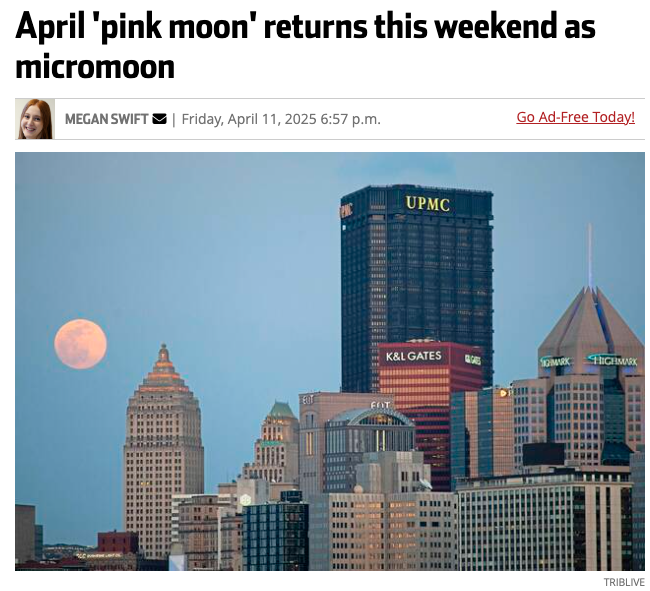気になる英語ニュース「今週末は4月の『ピンクムーン』!今年は特別な『マイクロムーン』として登場」
こんにちは!エミリーです。今日は、毎日海外のニュースをひとつピックアップして伝える「エミリーの気になるニュース」のコーナーをお届けします。
今回のニュースは、今週末に見られる4月の満月「ピンクムーン」についてです。なんと今年は特別な「マイクロムーン」としても観測できるんだそう!
実は私、夜空を見上げるのが大好きで、月の満ち欠けを見るのを楽しみにしています。英語では満月や月の状態を表す様々な表現があって、とても興味深いんですよ。
このニュース記事を題材に、英語学習のポイントを交えながら、天体現象や季節の変化について使われる英語表現を分かりやすく解説していきたいと思います。一緒に学んでいきましょう!
エミリーのニュースかんたん解説
The annual April “pink moon” is set to rise this weekend — and this year, it’s going to be a micromoon. The pink moon will reach peak illumination at 8:22 p.m. EDT Saturday in the United States, according to the U.S. Naval Observatory.
April’s full moon will rise when it’s at its farthest point from Earth, about 251,000 miles away, according to NASA. Saturday’s full moon will appear up to 14% smaller and 30% dimmer than a supermoon.
It’s called a pink moon because some Eastern Native American tribes call April’s full moon the “pink moon” due to its connection with early spring wildflowers, according to The Old Farmer’s Almanac. The Maine Farmers’ Almanac attributes the name to herb moss pink, a native Eastern U.S. plant that blooms in early spring.
For the best view, people should head to an open area and watch as it rises above the horizon, as it will appear larger than usual and have a golden hue. Other names for the pink moon have included the sprouting grass moon, the egg moon and, among coastal tribes, the fish moon — signifying the time when shad, a fish found along the Atlantic Coast, begin to spawn.
Other tribes named the April full moon after seasonal changes, referring to it as the “breaking ice moon” or the “moon when the ducks come back,” reflecting key signs of spring.
エミリーのニュースかんたん解説の日本語訳
毎年恒例の4月の「ピンクムーン」が今週末に昇ります — そして今年は「マイクロムーン」になります。米国海軍天文台によると、ピンクムーンは米国東部夏時間の土曜日午後8時22分に最大の明るさに達します。
NASAによると、4月の満月は地球から最も遠い点、約25万1000マイル離れた位置で昇るとのことです。土曜日の満月はスーパームーンと比較して最大14%小さく、30%暗く見えるでしょう。
「オールド・ファーマーズ・アルマナック」によると、東部ネイティブアメリカンの一部の部族が4月の満月を春の初めの野花との関連から「ピンクムーン」と呼んでいるため、この名前がついています。メイン州の農民のアルマナックでは、この名前は春の初めに咲く、米国東部原産のハーブモスピンク(学名:Phlox subulata)に由来するとしています。
最高の景色を楽しむには、開けた場所に行き、地平線上に昇る様子を見るといいでしょう。そうすると、通常よりも大きく見え、金色の色合いを帯びて見えるとのことです。ピンクムーンの他の名前には、「芽吹く草の月」、「卵の月」、沿岸部族の間では「魚の月」などがあります — これは大西洋沿岸に生息するシャッド(ニシン科の魚)が産卵を始める時期を表しています。
他の部族は4月の満月を季節の変化にちなんで名付け、「氷が割れる月」や「アヒルが戻ってくる月」と呼び、春の重要な兆しを反映させていました。
覚えておきたい英単語・英語表現
今回は、天体現象や季節の変化に関連する英単語や表現を紹介します!夜空や自然について英語で話す時に使えるフレーズばかりですよ。それでは、一緒に見ていきましょう!
- micromoon:(名詞)マイクロムーン(地球から最も遠い位置で見える満月)
Tonight’s full moon is a micromoon, so it will appear smaller than usual.
今夜の満月はマイクロムーンなので、通常よりも小さく見えるでしょう。 - peak illumination:(名詞句)最大照度、最も明るく見える時
The moon will reach its peak illumination at midnight.
月は真夜中に最大照度に達するでしょう。 - supermoon:(名詞)スーパームーン(地球に最も近い位置で見える満月)
Last month’s supermoon appeared much larger and brighter in the night sky.
先月のスーパームーンは夜空でとても大きく明るく見えました。 - golden hue:(名詞句)金色の色合い
The setting sun cast a golden hue across the ocean.
沈む太陽が海に金色の色合いを投げかけていました。 - wildflower:(名詞)野花
Spring is the perfect time to see wildflowers blooming in the meadows.
春は牧草地で野花が咲くのを見るのに最適な時期です。
友達とこのニュースについて話してみたよ!
ニュースについてディスカッションをしてみました!話し合うことで英語力がアップしますので、私たちの会話フレーズを参考にお友達と話をしてみてくださいね!
Emily: 10minガール。サイトの運営者。
Sara : エミリーの友達。グラフィックデザイナー。
Jake : エミリーの友達。旅行ライター兼ブロガー。
Emily: Hey guys! Did you hear about the pink moon happening this weekend? It’s going to be a micromoon this year!
Jake: A pink moon? That sounds amazing! Will it actually look pink in the sky?
Emily: Actually, despite the name, it won’t appear pink at all. The name comes from certain wildflowers that bloom in early spring in Eastern North America.
Sara: Oh, that’s interesting! I’ve heard of supermoons before, but what exactly is a micromoon?
Emily: It’s basically the opposite of a supermoon. When the full moon occurs at its farthest point from Earth, it appears smaller and dimmer than usual. That’s a micromoon!
Jake: So it’ll be up to 14% smaller and 30% dimmer than a supermoon? That’s a pretty significant difference.
Sara: I love all these astronomical terms in English. Micromoon, supermoon, blood moon, blue moon… they’re so descriptive and poetic.
Emily: I know, right? And I find it fascinating how different cultures have their own names for the moons based on what’s happening in nature during that time.
Jake: Like what? Are there other names for this April full moon?
Emily: Yes! Some Native American tribes called it the “sprouting grass moon” or the “egg moon” because of spring growth. Coastal tribes called it the “fish moon” because it’s when shad begin to spawn.
Sara: And some called it the “breaking ice moon” or the “moon when the ducks come back.” I love how these names connect the lunar cycle to seasonal changes.
Jake: That makes me think about how modern society has become disconnected from these natural rhythms. Our ancestors really paid attention to these cycles.
Emily: Absolutely! The moon was an important calendar for many cultures. It helped them know when to plant crops, when certain fish would be abundant, and so on.
Sara: So when exactly can we see this micromoon? The article mentioned Saturday evening, right?
Emily: Yes, it will reach peak illumination at 8:22 p.m. Eastern time on Saturday in the US. But the best time to view it is actually when it’s rising above the horizon.
Jake: Why is that? Does it look different when it’s rising?
Emily: When the moon is near the horizon, there’s an optical illusion that makes it appear larger, and it often has a beautiful golden hue. So even though it’s a micromoon, it’ll still look impressive when it first rises!
Sara: I’m definitely going to try to see it. Should we find an open area with a clear view of the eastern horizon?
Jake: That sounds like a plan! We could make a small event out of it – bring some snacks, practice our English conversation skills while we wait for the moon to rise.
Emily: I love that idea! We could even learn some more astronomy vocabulary in English while we’re at it.
Sara: And I could bring my camera to try capturing it. I’ve always wanted to improve my night photography skills.
Jake: Great! Should we meet around sunset to get set up before the moon rises?
Emily: Perfect! It’s settled then. Our own little pink micromoon viewing party this Saturday!
Sara: I can’t wait! Even if it’s smaller than usual, there’s something magical about watching the full moon rise.
Emily: Definitely! And now we all know the fascinating history behind its name too!
会話の日本語訳
エミリー:ねえ、みんな!今週末に起こるピンクムーンについて聞いた?今年はマイクロムーンになるんだって!
ジェイク:ピンクムーン?それはすごく素敵に聞こえるね!実際に空でピンク色に見えるの?
エミリー:実は、名前とは裏腹に、全くピンク色には見えないのよ。この名前は北米東部で春の初めに咲く特定の野花に由来しているんだ。
サラ:へえ、それは面白いわね!スーパームーンについては聞いたことがあるけど、マイクロムーンって正確には何なの?
エミリー:基本的にスーパームーンの反対よ。満月が地球から最も遠い点で起こると、通常よりも小さく暗く見えるの。それがマイクロムーン!
ジェイク:スーパームーンよりも最大14%小さく、30%暗くなるの?それはかなり大きな違いだね。
サラ:英語のこういった天文学用語が大好き。マイクロムーン、スーパームーン、ブラッドムーン、ブルームーン…とても描写的で詩的よね。
エミリー:そうでしょ?そして、異なる文化がその時期に自然で起こっていることに基づいて、月に独自の名前を付けているのは魅力的だと思うわ。
ジェイク:例えばどんな?この4月の満月には他の名前もあるの?
エミリー:はい!ネイティブアメリカンの一部の部族は春の成長から「芽吹く草の月」や「卵の月」と呼んでいたわ。沿岸部族は、シャッドが産卵を始める時期だから「魚の月」と呼んでいたの。
サラ:そして、一部は「氷が割れる月」や「アヒルが戻ってくる月」と呼んでいたのね。これらの名前が月の周期と季節の変化を結びつけているのが素敵だわ。
ジェイク:それを聞くと、現代社会がこういった自然のリズムからいかに切り離されているかを考えさせられるね。私たちの祖先は本当にこれらの周期に注意を払っていたんだ。
エミリー:その通り!月は多くの文化にとって重要なカレンダーだったの。それは作物を植える時期や、特定の魚が豊富になる時期などを知るのに役立ったわ。
サラ:それで、このマイクロムーンはいつ正確に見られるの?記事では土曜の夕方って言ってたわよね?
エミリー:そう、アメリカ東部時間の土曜日午後8時22分に最大照度に達するわ。でも実際に見るのに最適な時間は、地平線上に昇る時なの。
ジェイク:なぜ?昇る時は違って見えるの?
エミリー:月が地平線近くにある時、それを大きく見せる光学的錯覚があって、しばしば美しい金色の色合いを持つの。だから、マイクロムーンでも、最初に昇る時はやはり印象的に見えるわ!
サラ:絶対に見てみたいわ。東の地平線がはっきり見える開けた場所を探すべきかしら?
ジェイク:それはいいアイデアだね!ちょっとしたイベントにしよう – 軽食を持って行って、月が昇るのを待ちながら英会話の練習をするとか。
エミリー:そのアイデア大好き!ついでに、もっと英語の天文学の語彙も学べるわね。
サラ:私はカメラを持って行って撮影にチャレンジするわ。夜間撮影のスキルを向上させたいと思っていたの。
ジェイク:いいね!月が昇る前にセッティングするために、日没頃に会う?
エミリー:完璧!それじゃあ決まりね。今度の土曜日に私たち独自の小さなピンクマイクロムーン鑑賞パーティーね!
サラ:楽しみ!いつもより小さくても、満月が昇るのを見るのには何か魔法のようなものがあるわ。
エミリー:確かに!そして今や、その名前の背後にある魅力的な歴史も全員知ることができたわね!
もっと!ニュース本文で使われている英単語・英語表現
- annual:(形容詞)毎年の、年次の
- farthest point:(名詞句)最も遠い点
- dimmer:(形容詞)よりも暗い
- native:(形容詞)原産の、固有の
- herb moss pink:(名詞)ハーブモスピンク(学名:Phlox subulata、春に咲く花)
- horizon:(名詞)地平線
- sprouting:(形容詞)芽を出す、発芽する
- spawn:(動詞)産卵する
- reflecting:(動詞)反映する
これらの表現は、天体現象や自然について議論する際によく使われます。これらの語彙を習得することで、自然の変化について英語で議論できるようになるでしょう。
さらに!覚えておきたい関連する英単語・英語表現
- celestial event:(名詞)天体イベント
- lunar cycle:(名詞)月の周期
- full moon:(名詞)満月
- new moon:(名詞)新月
- waxing moon:(名詞)満ちていく月
- waning moon:(名詞)欠けていく月
- crescent moon:(名詞)三日月
- harvest moon:(名詞)収穫の月(秋分の日に最も近い満月)
- blue moon:(名詞)ブルームーン(1ヶ月に2回起こる満月の2回目)
- blood moon:(名詞)ブラッドムーン(皆既月食時の赤い月)
- lunar eclipse:(名詞)月食
- solar eclipse:(名詞)日食
- astronomical phenomenon:(名詞)天文現象
- stargazing:(名詞)星空観察
- meteor shower:(名詞)流星群
これらの単語は、月や天体現象に関連しています。これらの語彙を習得することで、夜空や天体について英語で話し合うことができるようになるでしょう。ニュースを読む際や、友人との会話の中で、これらの単語を使ってみてくださいね。
気になるニュース「今週末は4月の『ピンクムーン』!今年は特別な『マイクロムーン』として登場」でした。
Let’s enjoy 10 minutes of English together every day!
毎日10分、一緒に楽しく英語を学びましょう!








